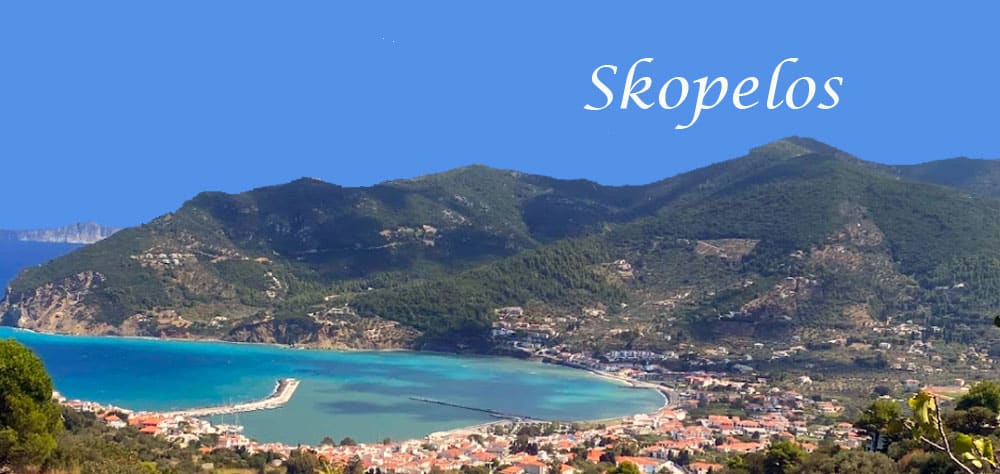Information about Skopelos island
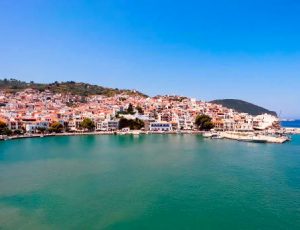
It is famous from the filming of the famous movie Mamma Mia but it is not only known for its beautiful cinematography.
It is a green island, where the pine trees almost touch the blue-green waters of the sea, an ideal destination for unforgettable holidays.
Skopelos also has a great cultural heritage. The island has been famous since ancient times for its wine, the great tradition in pottery and wood carving.
The visitor will be transported back in time by the unique ancient carved tombs from the Roman or early Christian period located in the Sendoukia area, the tomb of Prince Staphylos, where his famous sword was also found in the bay of the same name, while the Asklepiion of Skopelos in the location of Ampeliki which it is considered one of the most ancient sanctuaries of the god of Medicine, Asclepius.
In the long journey back to history and tradition, the island’s museums are important cradles! Museums, mansions and traditional houses “unlock” different aspects and eras of the rich history of Skopelos.
Skopelos is one of the few places in the world where temples, chapels and monasteries “bind” inextricably with nature and the unique residential identity and create a living painting.
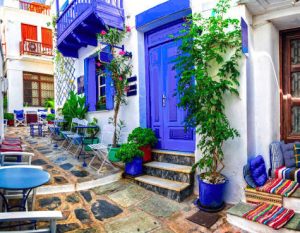
The picturesque villages with the imposing architecture of stone and wood complete the puzzle of the charming images of the island. Paved alleys, cobblestones, special architecture, huge bougainvillea on the balconies and the picturesque houses transport you to another era.
Dozens of dreamy beaches will seduce you with their blue-green waters and impressive vegetation ending without exaggeration in the sea! The lacy shores create natural coves and caves that will take you back to the past, when fearless pirates raided the unspoiled corners of the island.
Skopelos, in addition to impressing with its landscapes, beautiful routes, picturesque villages and heavenly beaches, also lends itself to activities in nature, such as kayaking, diving, cycling and hiking.
Skopelos with its little secrets as well as its popular places is waiting for you to get to know it and discover it.
Boats stop at both the port of Loutraki in the north west corner of the island and at Skopelos Town on the east coast. Ferry schedules often refer to Loutraki as Glossa which is the name of the lovely hill top town above the not particularly inspiring port. Both Glossa and Skopelos Town are delightful in their own ways – the former is unspoilt, totally Greek and steadfast in its resistance to all the more obvious trappings of tourism.
The island is known for its relaxed atmosphere and welcoming locals, creating a warm and inviting ambiance that permeates the nighttime festivities. Unlike some of the more raucous party destinations in Greece, Skopelos offers a more laid-back and authentic nightlife experience. Skopelos Town is awash with bars, cafes, gift shops and travel agencies but it’s still one of the loveliest towns in the archipelago with narrow cobbled streets winding up from the waterfront to the hilltop Venetian castle. The town has no fewer than 123 churches and some lovely traditional houses with brown timber balconies adorned with vivid bougainvillea and brightly coloured pot plants.
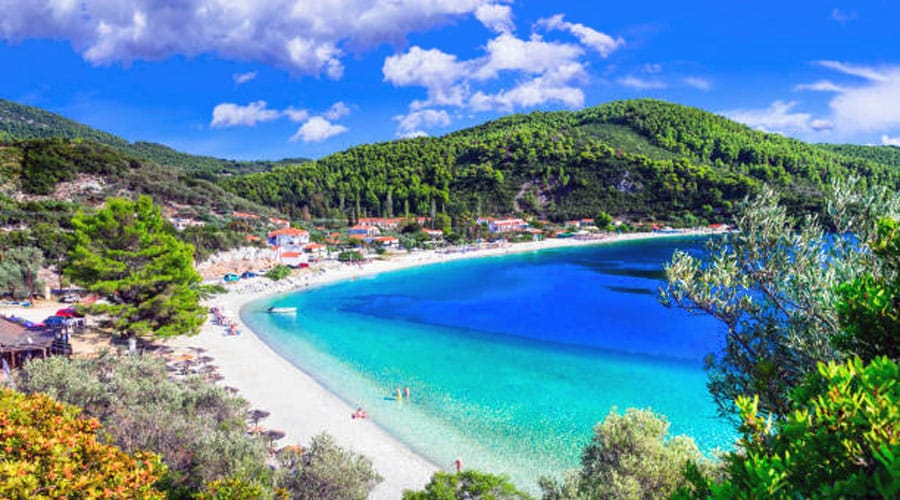
The island’s verdant countryside is littered with numerous impressive monasteries, many of which are in spectacular locations. Most are deserted but some are still inhabited by nuns who offer their loom-woven textiles for sale to a steady stream of summer visitors.
If you explore the interior you’ll also come across many old stone houses, called “kalyvia”, nestling amid the pine and cypress woods. The houses have distinctive outdoor ovens in which the islanders used to bake plums to produce the prunes for which Skopelos was once famous. You’ll still find prunes served up in various guises at tavernas all over the island.
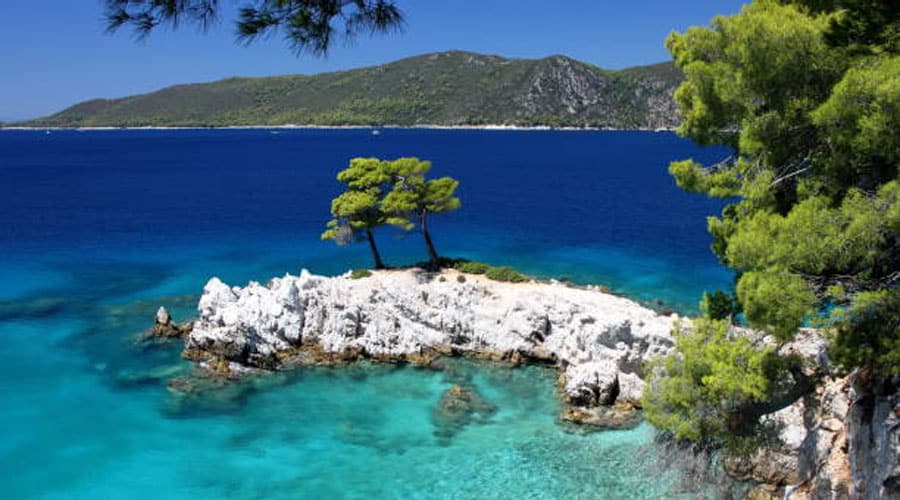
Most of the island’s beaches are pebbled and the best are scattered along the south and west coasts. At Agnondas on the south coast you can join the locals for a fresh fish lunch at one of the many tavernas lining the beach.
Panormos on the west coast is a full-blown holiday resort with plentiful hotels, tavernas, watersports and other tourist facilities. But if it’s solitude you crave, don a pair of sturdy walking shoes or take a water taxi from Skopelos Town and you’ll be able to find numerous secluded coves peppering the coastline, well off the tourist track.
Mythology
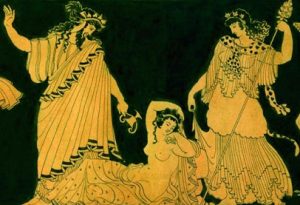
Theseus meets the daughter of Minos and Pasiphae, Ariadne, who falls in love with him and helps him by giving him a ball of thread, the well-known “Myth of Ariadne”, so that he can find the exit of the labyrinth. So Theseus kills the Minotaur, finds the exit and kidnaps Ariadne. Leaving Crete for Athens, Theseus and his companions make a stopover on the island of Naxos.
There, the god Dionysos appeared in his dream, ordering him to leave the island without Ariadne, because Ariadne was meant to be his wife. Drawing evidence from a local version of the myth, Dionysus takes Ariadne to the island of Lemnos, whereupon they have four sons together, Thoantas, Inopion, Staphylos and Peparithos.
This myth, like other related ones, verifies in the best way that Skopelos was inhabited by Minoans, constituting a Minoan colony during the years of Cretan-Minoan prosperity. It is also concluded that during the Minoan era, there were contacts and trade relations of the Cycladic islands with the North Aegean, Asia Minor and Argolis which, as is known, were centers of Mycenaean civilization
History
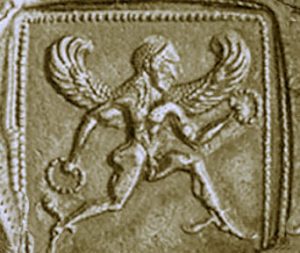
Even in the oracle of Delphi, the inhabitants of Peparithos had dedicated a statue of the god Apollo, because they had defeated the Carians in a battle.
Peparithos also had important ancient cities such as Knossos, Panormos and Selinous. Today, a large part of the castle in Panormos is preserved. Knossos was renamed Glossa.
In Byzantine times it was used as a place of exile. In the years of the Frankish rule, it was part of the duchy of Naxos, but later it was occupied by Licarios, who served the Byzantine emperor Michael VIII Palaiologos. Since then it remained Greek until 1453, to then pass under the rule of the Venetians.
Its many coves are a refuge for pirates. In 1538 the Turkish admiral Hayreddin Barbarossa captured the island and massacred its inhabitants. Foreign travelers who visited the island in the 16th c. they say it was uninhabited. Later it was colonized again but experienced many pirate raids.
In pre-revolutionary Greece, it was the lair of the fighters Nikotsaras and Yiannis Stathas. It was officially incorporated into Greece, along with the rest of the Sporades, in 1823.
Geography
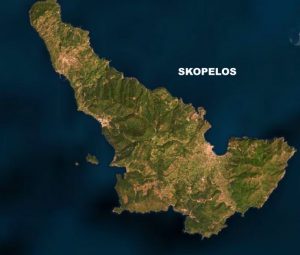
What impresses the visitor to this blessed beautiful island is the lush green forests that occupy the impressive majority of its surface. Rightfully so, Skopelos is considered one of the greenest islands in the Aegean.
The capital of Skopelos is the town of Chora or Skopelos. The municipalities of Glossa (former municipality of Glossa) include the villages of Glossa, Atheato and Loutraki. In addition, the administrative district of Klima includes the Old Klima as well as the Neo Klima (Elios).
Local Products and Cuisine
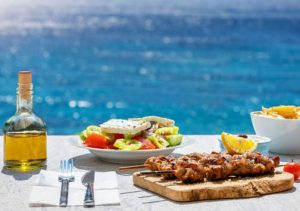
But gastronomy is not only an art of the land but also of the sea. The fresh fish and seafood in Skopelos excite locals and visitors, Greeks and foreigners.
All of nature’s wonderful raw materials allow talented scopers to “paint”! Savory and sweet local recipes are offered in tasteful restaurants and traditional taverns of the island.

The ritual of the meal is completed with the local sweets such as plum, almond, sour cherry and orange as well as others such as mustaleuria, rosettes, almond and hops, all of which taste like a dream! After all, the local cooperatives and producers hold all the secrets, so you can take some of the culinary magic of the place with you.
What to do
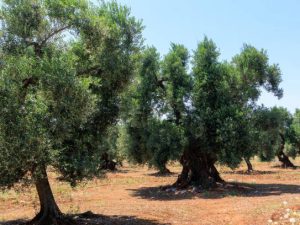
If you’re staying outside Skopelos Town it’s worth spending at least a day or two exploring the captivating and convoluted streets of this enchanting port town which boasts no less than 123 churches, many fine old mansions and some irresistible tiny shops selling local produce such as honey, prunes and home-made sweets.
Diving in Skopelos is an amazing experience for diving lovers. Especially at the point where you find the wreck of the trading ship Christoforos that sank near the shores of the island. There are two diving schools in Skopelos
Bars, cafes and craft shops line the waterfront and as you venture into the back streets you’ll delightful walkways, studded with pebbles and sea shells, winding their way up to the Venetian fortress which crowns the town. If you’re interested in the local churches you can get a map pinpointing their whereabouts from helpful Thalpos Travel on the waterfront.
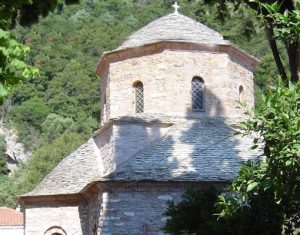
The town has a plentiful supply of craft, souvenir, antique and jewellery shops where you can ferret for unusual gifts including loom-woven textiles made by the local nuns. For an insight into a traditional Skopelan house, visit the Folklore Museum which has a range of local costumes, embroidery and furniture on display in a 19th century mansion behind the harbourfront.
Of the island’s 40 monasteries, five are clustered in the hills above Skopelos Town and can be visited either on foot or on a coach tour organised by one of the local travel agencies. Most of the monasteries have wonderful views of the island and at two of them – Moni Evangelistrias and Moni Timiou Prodromou you can buy handicrafts made by the nuns who live there.
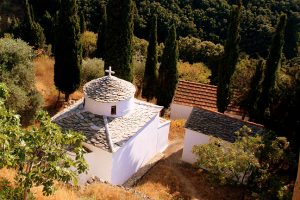
Seafood fans should take a trip out to the small port of Agnontas at the southern end of the island, where locals come to dine at the fish tavernas alongside the pebble beach.

You’ll be provided with binoculars, snorkeling gear and equipment to record dolphin signals and if you’re lucky you may spot some of the endangered Mediterranean Monk Seals which inhabit these waters. The trip is aboard a large caique captained by a marine biologist who makes the experience both educational and fun. You can make reservations through Madro Travel opposite the ferry dock in Skopelos Town.
Sights and attractions
Venetian Castle of Skopelos
The ruins of this 13th century Venetian fortress are visible from all over Skopelos Town and there is a pleasant walk up steps from the chapel of Panayitsa tou Pyrgou at the end of the harbour.
The climb is probably more interesting than the castle with a maze of narrow, whitewashed alleys at almost every turn and panoramic views over the harbour and bay. If you get lost just head upwards and you will find the castle and a welcome taverna.
The ruined fortress was first built in 340 BC by Philip of Macedonia and underwent lots of rebuilding, in particular by the Ghisi family in the 13th century. Unfortunately all that’s left now are a few broken walls and inside the church of Agios Athanisos. Oh, and the quite spectacular sights over the bay below.
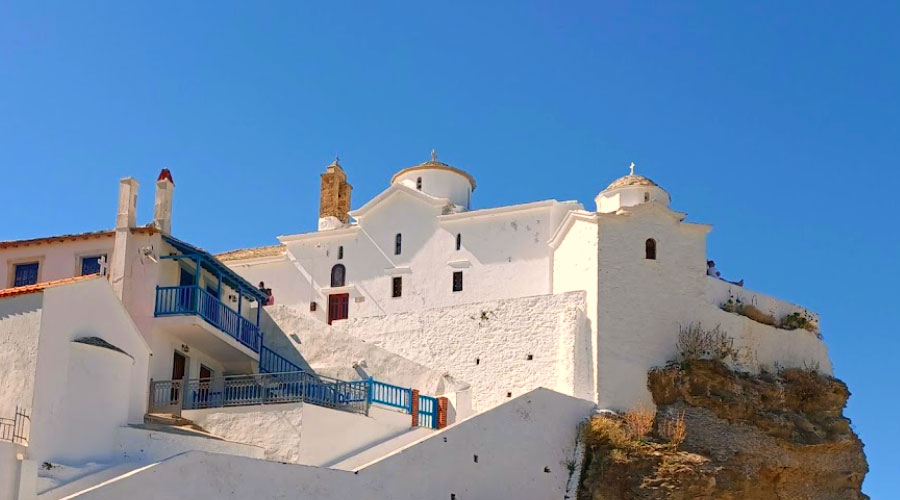
Agios Ioannis Chapel
This picture postcard chapel needs little introduction having featured in the hit movie Mama Mia and rated one of the top sights on Skopelos. It’s located in the remote region of Kastri on the north coast about 7 km east of Glossa.
Agios Ioannis is an impressive sight on top of the 100m high rock with amazing view along the coast of Skopelos and over the sea to neighbouring Alonissos.
Its origins are something of an island mystery. Some say locals saw a glow up there and carved 105 steps up to find an icon of Agios Ioannis. Every time they took the icon away it miraculously made its own way back so they eventually built a chapel to house it. The interior has several icons and old ecclesiastical bits and pieces. There is a small beach nearby that can get quite crowded in summer.
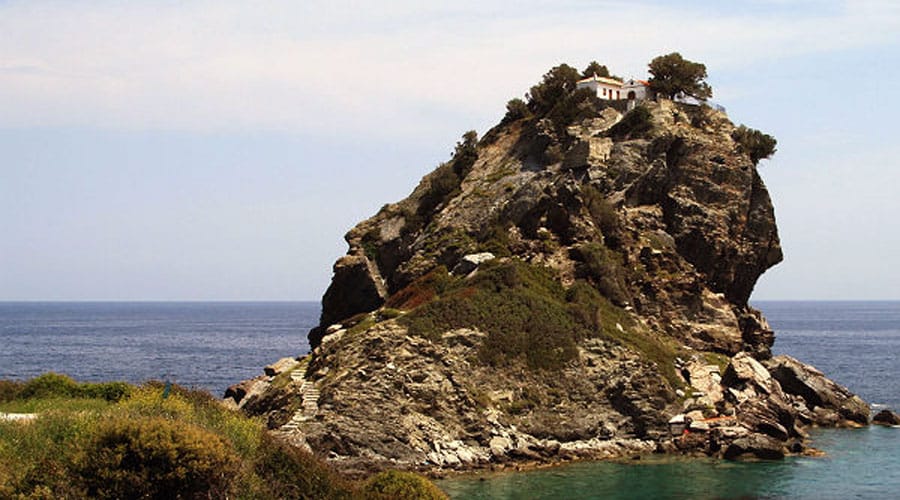
Ancient Stafylos
The most important and best-known archaeological site of Skopelos is Stafylos, located on the rocky peninsula, where there was a settlement during the Mycenaean period. Its importance is evident from the archaeological excavations that revealed findings that prove the island was inhabited during this period, while there are also remains of Mycenaean walls.
Of course, the most important and impressive archaeological discovery was the impressive 32 cm long sword with forged decoration and a handle coated with gold leaves, found inside the famous Mycenaean tomb and attributed to Staphylos.
This emblematic, for Skopelos, unique sword is exhibited in the Archaeological Museum of Athens. Behind the beach of Staphylos there is another beach, Velanio, where the archaeological dig brought to light traces of habitation during the Mycenaean era. It is remarkable that in the countryside of Skopelos, individual monuments documenting the productive activities of the ancient societies of Peparithos are constantly being discovered.
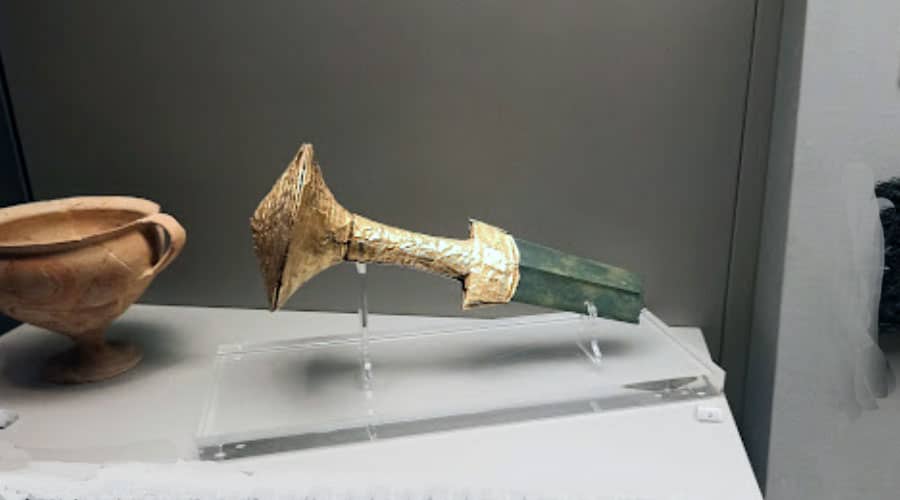
Folklore Museum of Skopelos
The Folklore Museum of Skopelos highlights the culture and tradition of the island. The museum presents a rich collection of objects and exhibits that reflect the history, art and daily life of the island’s inhabitants.
The museum has a diverse collection of traditional items, such as traditional clothing, tools, and everyday items that were used by the local inhabitants of the island.
The museum presents exhibitions explaining the culture and history of Skopelos. These exhibitions offer information about the traditions, customs and evolution of the island over the years.
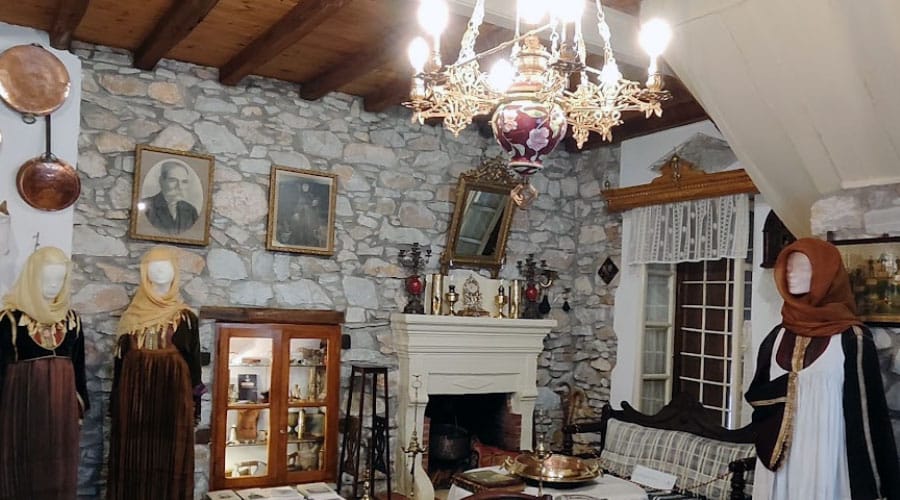
Asclepieion of Ancient Perarithos
One of the most important monuments of the ancient city of Peparithos is considered to be the Asklipieio, located in the “Livadi – Ampeliki” location on the southeast side of the gulf of Skopelos. Asklepiion of Skopelos is considered one of the most ancient sanctuaries of the god of medicine, Asklepiio. The Asclepius was located by the archaeological hoe, exploiting an inscribed votive base dedicated to the Asclepius.
Also, amphorae, red-figure Attic vases, parts of statues, clay figurines and coins have been discovered by the archaeological expeditions. The finds chronologically assign this sanctuary to the period from the 4th c. until the Hellenistic period. In a kiosk recently installed in the Archaeological site of Asklepiion, finds are displayed for visitors.
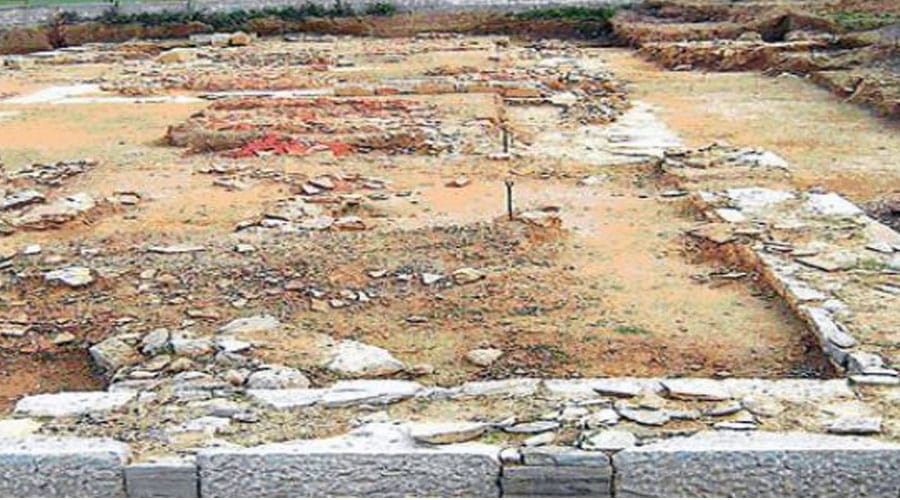
The tombs of Sendoukia
On the Karya mountain northwest of Skopelos Town and above the beautiful Monastery of Ag. Efstathiou with its excellent view, in the location of Sendoukia, there are four exceptional ancient tombs from the Roman or early Christian period that have the characteristic of being carved! In general Chests have many stories and legends to show with hidden treasures. Two of the graves are parallel to each other and separated by a third that is incomplete and another that is parallel to the three and located two meters further. The three completed tombs have 2.5m covers of monolithic slabs.
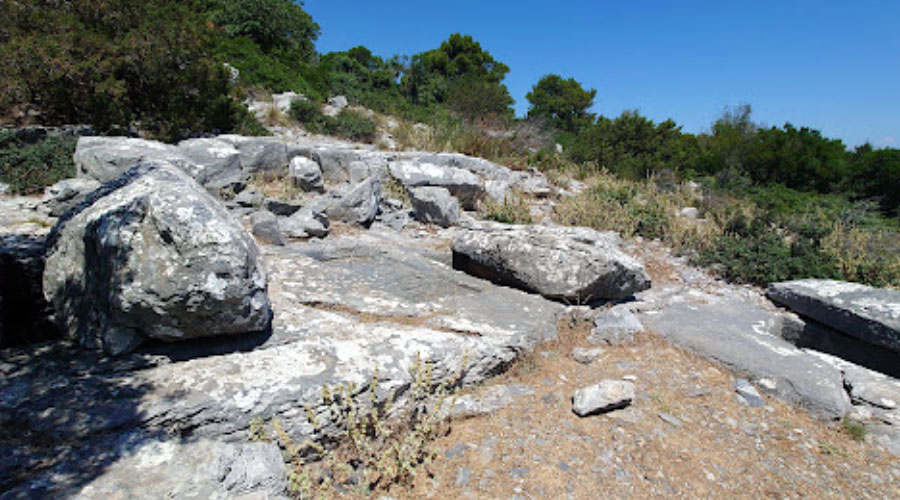
Towns and Villages
Skopelos is a picturesque Greek island with several charming villages scattered across its landscape. Each village has its own unique character, history, and attractions.Each village on Skopelos has its own charm and allure, making the island a diverse and delightful destination for travelers. Whether you prefer the bustling streets of Skopelos Town, the traditional ambiance of Glossa, or the coastal beauty of villages like Agnontas and Panormos, Skopelos offers a range of experiences to suit different tastes and preferences.
Chora the capital of Skopelos
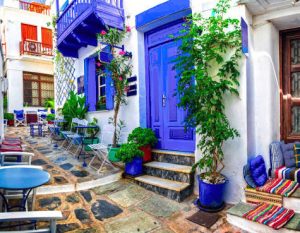
Various cultural events and photography exhibitions are organized throughout the year. In May and June, conferences and workshops are organized with topics from the long history of the island and research efforts for its further cultural and touristic development. Don’t miss the musical events that the Municipality organizes at the end of August and last for a week. On the last day, the plum festival takes place, where baked plums and wine are offered. By boat or with your own means of transport you will reach Sares, Agios Konstantinos and Glysteri beaches.
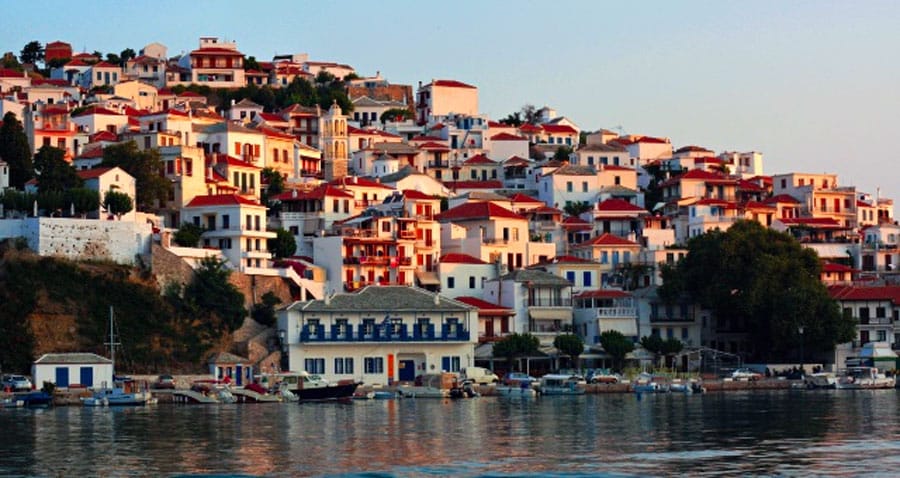
Glossa
The main tourist draw apart from Skopelos Town is the picturesque hillside village of Glossa, home to 1,200 people and views to die for.
The traditional village way of life has so far managed to stand fast against the annual and ever growing holiday visitor influx and the place oozes charm, in contrast to dull Loutraki below.
Many houses in Glossa have wooden balconies and the surrounding fields are full of plum and almond trees. Several dirt roads provide walks to nearby sights of interest. These include the monastery of Agion Taxiarchon, built on the ruins of a 7th century Byzantine church and the Gourouni Cape lighthouse.
Tracks lead down to often deserted beaches with coves at Myrtia and Koutria to the north-west and Perivoli, Pethameni, Hondrogiorgi, Keramoto,Mavraki and Spilia in the north-east. Many however are difficult to find and only Spilia and Perivoli have roads leading to them.
Pethameni is at the bottom of a precipitous path but Hondrogiorgi has easier access and is popular with locals.
At Spilia there is a cave and a chapel to Agios Ioannis built on a spectacular headland above a double coved beach. The headland was created when the cliffs collapsed into the sea and the pretty chapel featured strongly in the hit movie musical Mamma Mia.
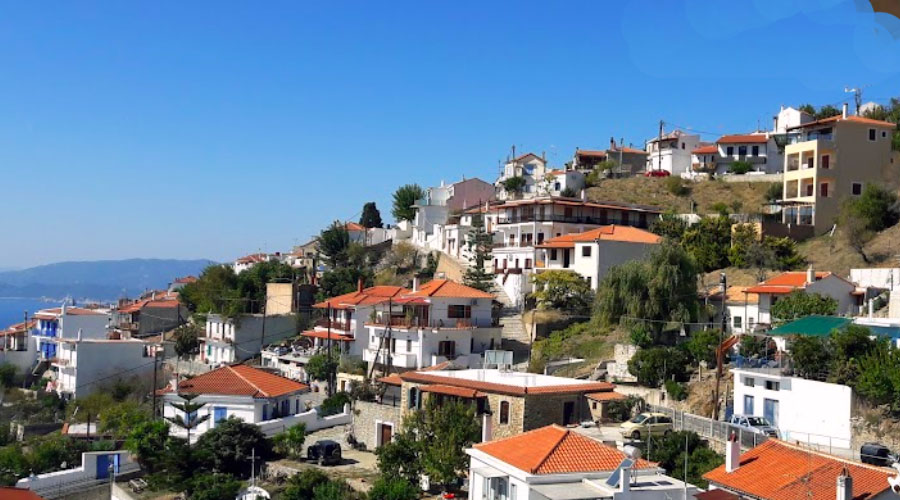
Neo Klima
Neo Klima is a serene coastal village nestled between hills covered in pine forests. It features a picturesque bay with crystal-clear waters. The village is an excellent place to relax on the beach, swim, and enjoy fresh seafood in the local tavernas.
Klima has a picturesque harbor with colorful traditional buildings lining the waterfront. This harbor is often filled with fishing boats and sailboats, adding to its charm.
There are several small beaches in the vicinity, including Klima Beach and Limnonari Beach. These beaches are ideal for swimming and sunbathing.
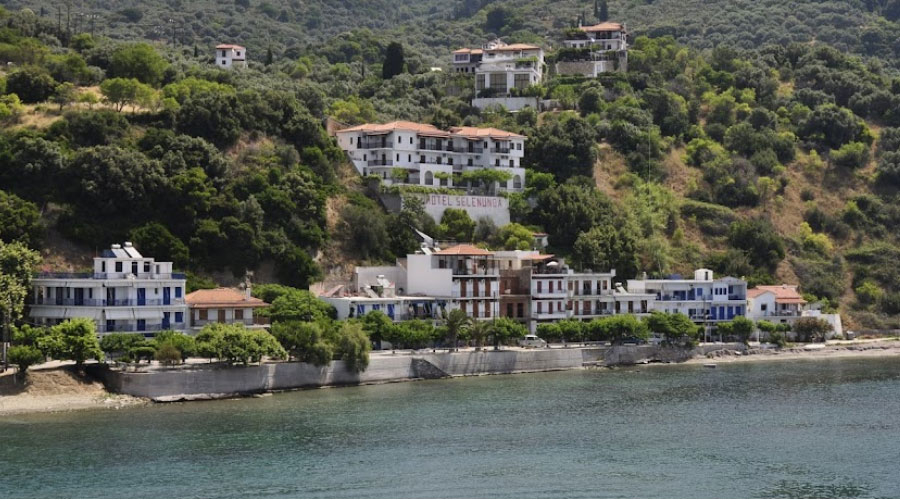
Loutraki
Loutraki is the small port for the hill village of Glossa and the first port of call for ferries from Skiathos and the mainland.
There is a long, cement quay, a scruffy collection of houses and some imposing cliffs behind. Not many visitors stay here, preferring the more attractive hill village of Glossa above.
But this quiet fishing village has kept to its traditional ways and has Loutraki nothing of the commercialism found in the main port of Skopelos Town, although cafes and tavernas are plentiful and the village has hotel rooms to supplement the accommodation in Glossa.
There are beaches nearby, the largest is a rather unkempt pebble right behind the pier and some quieter coves within walking distance, the most notable being a shingle beach at Katalakou in the south and at Glystra to the north.
Loutraki was known as Selinounda in ancient times and there are ruins aplenty such as a Roman bathhouse, the remains of a temple to Athena and an ancient agora market place.
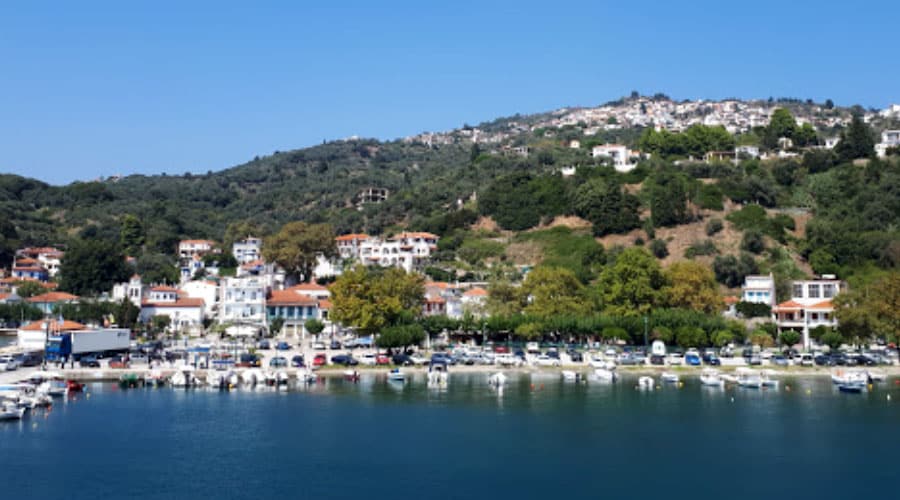
Agnontas
Agnontas is a charming coastal village located on the Greek island of Skopelos. Situated on the southwestern coast of the island, Agnontas offers a tranquil and picturesque setting for visitors looking to escape the hustle and bustle of larger towns.
With its small harbor, colorful houses, and serene atmosphere, Agnontas is a hidden gem on Skopelos. Here’s some information about this lovely village:
Agnontas is approximately 9 kilometers (5.6 miles) southwest of Skopelos Town (Chora), the capital of the island. It is well-connected by road, making it accessible for tourists. The village is centered around a picturesque harbor that is often filled with fishing boats and small yachts. The harbor area is lined with tavernas and cafes, making it a perfect spot to enjoy a meal by the sea.
Agnontas boasts a beautiful pebble beach with clear waters. This beach is ideal for swimming and sunbathing, and it is well-sheltered from strong winds, making it a peaceful place to relax.
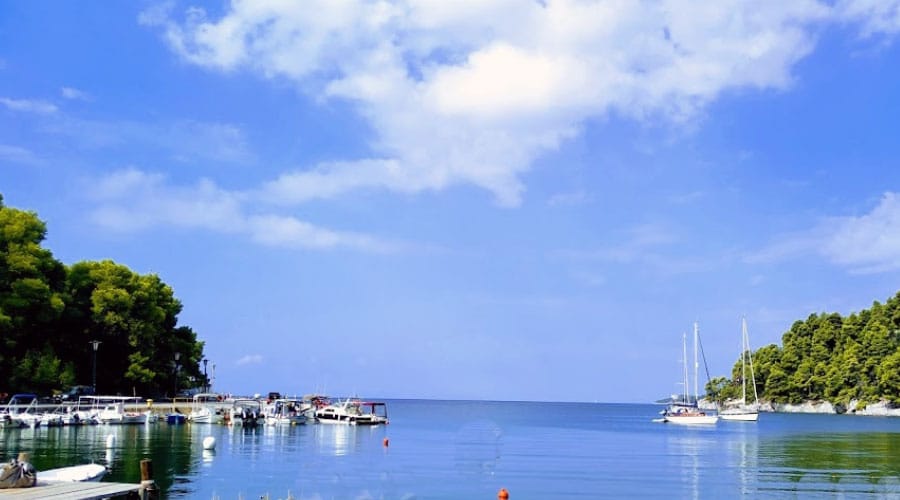
Panormos
Panormos is renowned for its stunning natural surroundings. The village is nestled in a sheltered bay with a beautiful sandy beach and crystal-clear waters. The lush green hills and pine-covered slopes that surround the village create a tranquil and idyllic setting.
Panormos Beach is the main attraction in the village. It is a well-organized sandy beach with sunbeds and umbrellas available for visitors. The calm and shallow waters make it suitable for swimming, especially for families with children. Water sports activities are also available here.
Panormos offers a range of accommodation options for tourists, including hotels, apartments, and traditional guesthouses. Many of these accommodations provide stunning sea views and easy access to the beach.
The village has a variety of tavernas and restaurants where you can savor traditional Greek and Mediterranean cuisine. Fresh seafood is a specialty in many of these establishments, and you can enjoy your meal with a view of the sea.
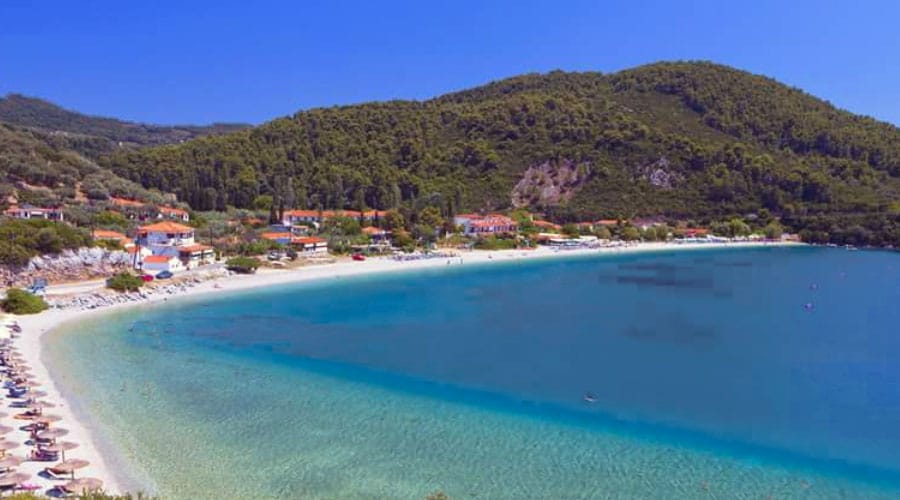
Where to stay
Skopelos is a relatively small island and attracts hordes of holidaymakers in high season. Many hotels are booked up months in advance by the tour companies so it’s best to arrange holiday accommodation before arriving on the island, especially in July and August.
The Hotel Owners Association of Magensia has lists of available rooms for rent. It’s located next to the town hall on the main waterfront. Room owners meet arriving ferries. The bigger hotels in Skopelos Town are usually full except in the spring or autumn but there are many comfortable rooms to rent, at good rates.
The main Skopelos beach holiday resorts at Panormos and Stafylos are well stocked with hotels, apartments and studios and there are private houses to rent. Away from the crowds is the hilltop town of Glossa in the north of Skopelos and taverna owners usually know of rooms to let in the village or nearby.
Getting around Skopelos
Roads on Skopelos are generally good. The main asphalt road runs for around 35 kilometres from Skopelos town goes through Stafylos (4 kilometres) then Agnontas (8 kilometres), Panormos (18 kilometres) then Milia and to the villages of Elios (24 kilometres) and Klima (28 kilometres) then to Glossa (32 kilometres) when it drops down into the port of Loutraki.
The route is very scenic, wending its way through pine forests, olive groves and plum orchards often skirting the island beaches. Minor roads turn to gravel and dirt. There are four petrol stations on Skopelos so filling no problem but finding a parking place in Skopelos Town can be difficult in August as cars are banned from all but the main road to the port and along the waterfront.
Three buses daily run the length of the island from Skopelos to Stafylos, Agnontas, Panormos, Milia, Elios, Klima, Glossa then back through Loutraki, Milia and Agnontas. There are also several buses daily to Agnontas. Extra bus services are added during the high summer season. The main bus stop in Skopelos Town is 100 yards from the harbour next to the taxi rank.
The main taxi stand is on the Skopelos Town waterfront near the bus station. Taxis have fixed rates to various destinations. Note that ferries often leave Skopelos port at around 7am when taxis can be in short supply. It is often a good idea to hang on to your hire car until the last minute. There are also the usual cars and mopeds to rent in Skopelos Town and Elios. Most are found on the eastern outskirts of Skopelos Town and some offer very cheap deals.
Day trips
Skopelos is a delight to explore by day with its lush, green interior criss-crossed by ancient paths which lure hikers, bikers and horse riders ever deeper into the densely forested countryside. The island is awash with olive groves, plum, pear and almond orchards along with swathes of tall pines which sweep down to secluded coves. Follow the dirt tracks to the myriad of monasteries and churches which speckle Skopelos and take the time to browse the streets of the island’s two main settlements which rate among the most charming towns in the Greek islands.
If you’re staying outside Skopelos Town it’s worth spending at least a day or two exploring the captivating and convoluted streets of this enchanting port town which boasts no less than 123 churches, many fine old mansions and some irresistible tiny shops selling local produce such as honey, prunes and home-made sweets.
Bars, cafes and craft shops line the waterfront and as you venture into the back streets you’ll delightful walkways, studded with pebbles and sea shells, winding their way up to the Venetian fortress which crowns the town. If you’re interested in the local churches you can get a map pinpointing their whereabouts from helpful Thalpos Travel on the waterfront.
The church nearest the ruined castle is Agios Athanasios which was built in the 11th century and houses some fine 16th century frescoes. The castle itself was originally built by King Philip of Macedon in the 4th century BC and rebuilt by the Venetians who ruled the island for 300 years from 1204.
The town has a plentiful supply of craft, souvenir, antique and jewellery shops where you can ferret for unusual gifts including loom-woven textiles made by the local nuns. For an insight into a traditional Skopelan house, visit the Folklore Museum which has a range of local costumes, embroidery and furniture on display in a 19th century mansion behind the harbourfront.
Of the island’s 40 monasteries, five are clustered in the hills above Skopelos Town and can be visited either on foot or on a coach tour organised by one of the local travel agencies. Most of the monasteries have wonderful views of the island and at two of them – Moni Evangelistrias and Moni Timiou Prodromou – you can buy handicrafts made by the nuns who live there.
A monastery well worth visiting in the north of the island is Agios Ioannis which perches quite spectacularly on a boulder above the sea. If you’re a keen hiker you can make a four-hour round trip from the lovely hilltop town of Glossa which is a must on your list of places to visit. The town is blissfully peaceful and unspoilt, still very Greek in character but with remnants of the Venetian and Turkish occupations. The whitewashed, red-roofed houses cling to a steep hillside above the island’s second port of Loutraki.
Seafood fans should take a trip out to the small port of Agnontas at the southern end of the island, where locals come to dine at the fish tavernas alongside the pebble beach.
If you’re interested in the local marine life, book yourself on a weekend cruise of the National Marine Park which incorporates the nearby island of Alonissos and surrounding islets. You’ll be provided with binoculars, snorkeling gear and equipment to record dolphin signals and if you’re lucky you may spot some of the endangered Mediterranean Monk Seals which inhabit these waters. The trip is aboard a large caique captained by a marine biologist who makes the experience both educational and fun. You can make reservations through Madro Travel opposite the ferry dock in Skopelos Town.
How to get to Skopelos
By Air
There is no airport on Skopelos, nor any likelihood of one being built. Visitors arrive by boat after flying to the neighbouring Skiathos International (JSI) airport. Skiathos airport was opened in 1972 and lies about two kilometres from the port where ferries can be caught for Skopelos.
Most visitors to Skopelos fly to Skiathos, get a taxi to the port where there are daily ferry and catamaran services that operate to the port of Loutraki on the south-west coast, a journey time of 30 minutes and/or to the main port of Skopelos Town which takes about one hour. An alternative is to fly to Athens and get an internal domestic flight to Skiathos. This is probably the most flexible option and can be the cheapest but internal flights to Skiathos usualy leave very early in the morning.
Visitors can also fly to Thessaloniki Airport on the mainland. Seasonal cheap flights operate from April to October and there are ferry sailings from there or from the port at Volos
By Ferry
Skopelos is well-connected to the mainland and neighboring islands by ferry. The main ferry route to Skopelos is typically from the port of Volos on the mainland. Volos serves as a major gateway to the Northern Sporades. The ferry schedule to Skopelos can vary seasonally. During the summer months, there are more frequent departures, while in the off-season, schedules may be less frequent. The ferry journey from Volos to Skopelos typically takes around 3 to 4 hours on a conventional ferry and about 2 to 2.5 hours on a high-speed catamaran.
Several ferry companies operate routes to Skopelos, including Hellenic Seaways, ANES Ferries, and more. The availability of ferry companies and schedules can vary depending on the season, so it’s advisable to check in advance and make reservations if possible. Ferries traveling to Skopelos come in various types, including conventional ferries and high-speed catamarans. The choice between these types often depends on your preferred travel speed and comfort level.
